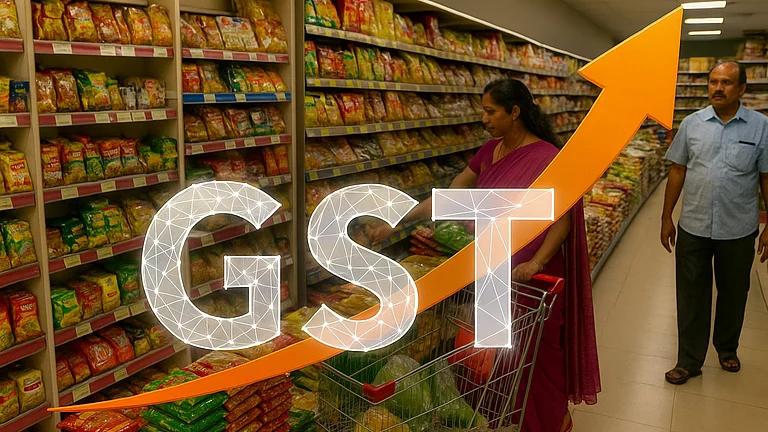GST 2.0 aims to simplify taxes with two slabs, easing middle-class burdens and driving demand.
Markets are upbeat, expecting lower rates to lift margins and volumes, though brokerages remain divided.
The impact will hinge on fiscal math, price checks, competition, and company strategies.
Can GST 2.0 Actually Live Up to the Hype and Boost Demand?
The stock market has already written its script for GST 2.0, betting on huge consumption gains, however, Kotak warns that investors risk walking into another “narrative trap”
As India strains under the weight of Donald Trump’s massive 50% tariffs on its exports, it is set to soon find relief a little closer to home. The Modi government has promised a sweeping overhaul of the Goods and Services Tax (GST), to be unveiled by Diwali. From the ramparts of the Red Fort on Independence Day, the Prime Minister hinted at a ‘next-gen’ GST framework, one that strips off the cluttered four-slab structure into just two.
The GST Council, made up of finance ministers of all the states and Union Territories, is meeting on September 3 and 4 to decide on a number of issues, including rationalisation of rates and compensation to states, among others. The goal stretched beyond just simplifying the tax structure, to spur domestic demand, and lighten the tax burden on India’s middle class.
For the stock market, that announcement was enough glitter. Investors wasted no time sketching a narrative of tax-led demand revival, sending automobile, cement, consumer durables, staples, lenders and retail counters sharply higher.
Kotak Institutional Equities believes the optimism was driven by investors betting that GST rates on many of these products could be trimmed, moving from 12% and 28% brackets down to 5% and 18%, respectively.
Meanwhile, the underlying hopes of the GST cut bolstering corporate balance sheets relies on expectations that companies will likely retain part or most of the tax savings, boosting margins and profitability, while lower prices could lift volumes, benefiting both core sectors and derivative plays like lenders and retailers, KIE believes.
Unlike the euphoric retail investor, institutional opinion is split. While some brokerages see the GST rationalization as the elixir needed to revive demand, others look at it with cautious lens. PL Capital sits in the former camp, arguing that a leaner GST regime will not only reduce classification disputes but also lower the effective tax on household goods, spurring consumption.
It forecasts major gains for automakers across two- and three-wheelers, passenger cars, tractors and commercial vehicles. Beyond autos, it identifies a wide swathe of consumer goods, from stationery and processed food to cement, air-conditioners, footwear, medicines and sanitaryware, as likely beneficiaries of a simpler tax regime.
Kotak, however, looks at the market reaction to the GST cuts with a cautious lens. The firm stated that the market’s mechanical response to the government’s plan to rationalize the GST structure shows the powerful hold of narratives on the investment community and low amount of skepticism about a new narrative, despite the rather poor track record of such stories in the past 2-3 years. Going a step further, KIE touted the basis for such optimism (flows, group think and relative performance) quite flimsy.
Along those lines, the brokerage believes the market’s optimism over GST cuts is just a sign of investors falling in yet another narrative pit. “The market has been in the thrall of narratives for a while, with a new narrative catching the fancy of the market every few weeks, only for it to disappear quietly later,” it said.
That scepticism goes further. Kotak urges investors to pay less attention to sweeping storylines and more to the risks of disruption, whether from regulatory oversight, industry-specific shifts, or regional upstarts snapping at the heels of incumbents.
On one point, though, there is broad agreement, the true impact of GST 2.0 on corporate earnings will be shaped by multiple variables, not just rate cuts. The first is obvious, what the final numbers look like, which will depend on the fiscal calculations of both the centre and the states. The second lies in the government’s willingness to police retail prices. If profiteering is curbed, more of the gains will flow to consumers. Third, the dynamics of competition, as branded goods may be able to defend margins, while commoditised sectors could see prices fall more sharply. Finally, there is corporate strategy, whether companies choose to pocket savings, pass them on, or use them to claw market share from rivals.
Stripping away the noise, Kotak’s logic says that in fiercely competitive markets, tax cuts tend to filter through to lower prices, with demand growth following close behind. That, ultimately, is what the government is gambling on as GST rationalisation is not just a technocratic fix to a complex system, it is also a political bet that cheaper goods and higher volumes will keep India’s consumption engine humming, even as exports face unprecedented headwinds.
